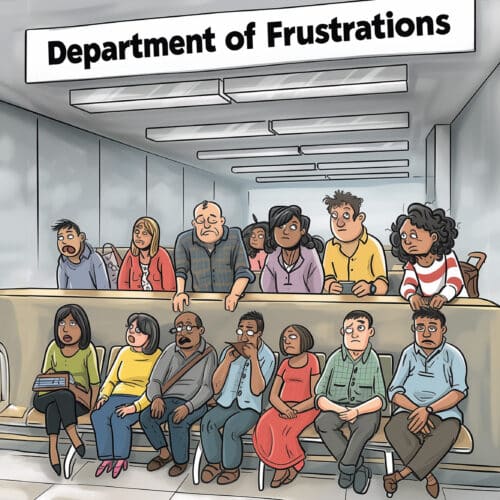“Perseverance is not a long race; it is many short races one after the other.”
– Walter Elliot
Today I’m pondering the emotional, mental, and physical stress so many of my clients and their teams face in what William Bridges called The Neutral Zone or second stage of change. He meant “neutral” as in “neutral gear,” out of control and not sure how to manage it all so you can get to where you want to go. Over here at PointerWise, we fondly refer to this stage of change as the Chaos Zone.
If you haven’t yet met my pet dragon, Daisy, check out our blog entitled Leading Change and Taming Your Pet Dragon. Daisy is the quirky name I’ve given my reptilian brain, my little mental dragon who frets constantly about change and risks – and really cannot be reasoned with. You have a pet dragon too, assigned at birth. Daisy is here to add some light-heartedness to our discussion and to help me get through all of the big, fat, hairy, and scary changes in my life. Right now, my husband is retiring, my mom is moving in with us, and my daughter and I are working to build this business together in an uncertain world. Lots to be worried about. That’s Daisy’s job and she is very, very good at it.
I’ve learned that once you’ve gotten past your anxious, fire-breathing pet to land on a decision that means losing “the way things are and have been,” you find yourself in a land of testing, exploring, shaping, and reshaping strategies to find how to live the new way. This part can be exhilarating and bone crushing, all in one day. Actually all in 5 minutes in my house. And when things aren’t going well or just don’t work the way we hoped, Daisy wakes up and starts screaming “GO BACK! GO BACK NOW! YOU’RE AN IDIOT! THOSE PEOPLE OVER THERE ARE TOO! THIS WON’T WORK! YOU SHOULD HAVE LISTENED TO ME!”
Adopting Humor is the Best Weapon of All
 When you are leading people through change at work or at home, the Chaos Zone is the most challenging part – just when you thought that deciding to change was soul-sucking and you have nothing left to give. First, remember, It’s a good habit for any leader to find lightheartedness and humor even when, especially when the score is Change – 0, Wall of Impermeable Resistance – 10. This is a way to connect with your team and engender a sense of “we can do this” together. Sounds easy when it’s been a good day. I’m not suggesting you laugh when a process you’re trying to implement leads to a $50,000 mistake. I am suggesting that how big you make that in the scheme of where you’re going is the difference between success and failure, the difference between your people giving up for a few hours versus a few weeks or months. We can always laugh at our pet dragons – always find a way to see how we catastrophize what’s going on in our little slices of paradise.
When you are leading people through change at work or at home, the Chaos Zone is the most challenging part – just when you thought that deciding to change was soul-sucking and you have nothing left to give. First, remember, It’s a good habit for any leader to find lightheartedness and humor even when, especially when the score is Change – 0, Wall of Impermeable Resistance – 10. This is a way to connect with your team and engender a sense of “we can do this” together. Sounds easy when it’s been a good day. I’m not suggesting you laugh when a process you’re trying to implement leads to a $50,000 mistake. I am suggesting that how big you make that in the scheme of where you’re going is the difference between success and failure, the difference between your people giving up for a few hours versus a few weeks or months. We can always laugh at our pet dragons – always find a way to see how we catastrophize what’s going on in our little slices of paradise.
Understanding the Chaos Zone
In the world of corporate transitions, the Chaos Zone is that middle ground where the old is gone, but the new hasn’t fully settled in. It’s a phase of uncertainty, confusion, and, yes, chaos. Here, teams might feel disoriented, much like Daisy trying to get the hang of sleeping in a new high-tech bed after losing her old and comfy but burnt-up futon. (Yes, if you haven’t been following along, my pet dragon sleeps on a bed. A bed in my head where she lives and works her fire-breathing talents to scare me away from trying new things.) The Chaos Zone is where leaders need to step up with empathy and strategy.
Transform your team’s turmoil into triumph.
Explore PointerWise’s expert services and lead your team with confidence.
Applying the 2 C’s and 4 P’s in Corporate Change
Navigating through the Chaos Zone requires a special toolkit: the 2 C’s (Care and Concern) and the 4 P’s (Purpose, Picture, Plan, and Part), as outlined by William Bridges in his landmark book, Transitions.
The 2 C’s: Care and Concern
Showing Care and Concern in any change context, whether it’s corporate or family or friend relationships, means listening empathetically and responding to what you hear and not what you are thinking. In other words, stop listening to answer and start listening to hear. Try not to formulate your planned answers while the person you seek to support is speaking. Perhaps that person is speaking the same complaint you heard last week or from others who feel the same. It’s your job to listen like you care for this particular person and want to know how it is to be them, even if you’ve heard it before. Even if you believe it’s weak or annoying or wrong to feel the way they feel. It’s their world you are listening to, not your own. Ever have your significant other endlessly complete your sentences for you and interrupt the flow of your sharing a heartfelt story with “ok, yeah, uh-huh, right” that feels more like a cattle prod than an open heart? That’s not who you want to be if you expect your team to experience Care and Concern in the Chaos Zone that they need to go back to work with a sense of being seen, heard and valued. If your goal is just to be right, you need some rewiring. Your goal is to lead. And to lead, you have to sit on your own story and just dwell with your team when they are experiencing the disorientation and lack of confidence that comes with change.

Care and Concern are shown when you openly appreciate the sharing and want your team members to know you “get it” – what it is to be them – and that you don’t take it lightly or undervalue the sacrifices they are making. It’s about asking them what they need and how you can help them through this phase. Often, just being heard is what they need. But they might also need to have adjustments in the strategy or timetable for their work that will help them support the organization through change. You may or may not be able to offer such adjustments. But being too rigid can reflect a lack of Concern when just considering requests without immediate dismissal or denial can make all the difference in the experience of your team member. Care and Concern is about listening to their frustrations, acknowledging the steep learning curve, and offering support, just like I would console Daisy about her app glitches.
As you may have guessed, Care and Concern require slowing down and pushing the pause button in the pace and tone of what can often be drill sergeant territory for a leader tasked with accomplishing challenging changes in an organization. It may not come naturally, but it will come mindfully if you understand the impact.
Have questions about managing change within your team?
Our experts are here to help. Get in touch with PointerWise today!
The 4 P’s: Purpose, Picture, Plan and Part
The 4 P’s proposed by Bridge’s as the additional keys to unlocking your team’s best performance in the Chaos Zone are briefly described here:
Purpose: For any change, like shifting to a remote work model, clarify the Purpose. Explain the benefits, such as flexibility and work-life balance, to your team. It’s like reminding my pet dragon, Daisy, that her new high-tech adjustable bed, which replaced her old burnt-up futon, was purchased for the purpose of ensuring better sleep and support for her aging back.
Picture: Paint a clear Picture of the future. If you’re undergoing a merger, describe what the combined entity will look and feel like and how the combined products and people will produce greater successes and experiences for employees and customers. Literally paint the picture of what those successes and experiences will look and feel like to those who get to experience them. Show how this will create new opportunities for growth and innovation. For my pet dragon, Daisy, this would help her visualize waking up refreshed on her new high-tech bed once she gets used to it and learns how to use it.
 Plan: You will need to share and reshare the Plan to navigate whatever change you’re leading, to the point of sometimes being frustrated. It’s important to understand that your team knows the plan but still needs to be anchored to it regularly so that they don’t forget it in the midst of sometimes overwhelming crises and distractions as things don’t go as planned. Having a plan doesn’t mean the plan works perfectly. And people need to be reminded that setbacks and errors in planning or implementation don’t mean the overall plan should be thrown out. It’s your job as a leader to help them see this in a palpable and ever-present way. For instance, if you’re going paperless, and customers are lodging twice the normal complaints due to delays and errors in digitizing files, you’ll need to remind the team that the plan is still a good one and why. Explain that these setbacks and challenges are to be expected, and show them, literally, how the team is making progress toward the overall end game. Keep returning to the plan, talking about it, and making adjustments as needed to ensure the team feels listened to and still keeps rowing toward the change. For Daisy, this might be helping her remember that despite problems with the bed control application on her phone and her frustrations with learning how it works or the system crashing, the learning process is never a straight line, and with practice and perhaps a few calls to customer service, she will be operating that Zero-G setting with no trouble very soon.
Plan: You will need to share and reshare the Plan to navigate whatever change you’re leading, to the point of sometimes being frustrated. It’s important to understand that your team knows the plan but still needs to be anchored to it regularly so that they don’t forget it in the midst of sometimes overwhelming crises and distractions as things don’t go as planned. Having a plan doesn’t mean the plan works perfectly. And people need to be reminded that setbacks and errors in planning or implementation don’t mean the overall plan should be thrown out. It’s your job as a leader to help them see this in a palpable and ever-present way. For instance, if you’re going paperless, and customers are lodging twice the normal complaints due to delays and errors in digitizing files, you’ll need to remind the team that the plan is still a good one and why. Explain that these setbacks and challenges are to be expected, and show them, literally, how the team is making progress toward the overall end game. Keep returning to the plan, talking about it, and making adjustments as needed to ensure the team feels listened to and still keeps rowing toward the change. For Daisy, this might be helping her remember that despite problems with the bed control application on her phone and her frustrations with learning how it works or the system crashing, the learning process is never a straight line, and with practice and perhaps a few calls to customer service, she will be operating that Zero-G setting with no trouble very soon.
Part: When team members feel overwhelmed by the list of their “to do’s” and competing deadlines and priorities, your job as a leader is to remind them of what you need from them right now. Break it down with them into smaller bites, or in Daisy’s case, fiery breaths. Ensure everyone knows their Part in the change, and then repeat it to team members who need reassurance when they have tough days or reversals in progress. I once oversaw a corporate integration for an HR team, and we issued offer letters to all of our newly acquired employees stating that they would be making $0.00. A frantic team member came to me, white as a ghost to explain the mistake. I helped her laugh at the ridiculousness of such an offer and we mapped out what the team needed from her in that moment, which included contacting each new employee directly to apologize and promise a new offer letter with the correct compensation listed. I encouraged her to find some humor in a difficult situation and to understand that her part was not tied to the mistake, but to accomplishing the overall goal of getting the offer letters she and her team had worked on so hard re-issued and signed. For my pet dragon, Daisy, if she accidentally burned her bed during a fit of irritation, my job would be to help her walk through whether the burned section of her mattress was a problem or instead remind her fondly of her old futon and therefore “the plan” changed for the better.
Real-Life Examples in the Chaos Zone
Implementing a New System: The Chaos Zone appears when a company introduces a new IT system. There’s a period of adjustment, with potential technical issues and a learning curve for employees. Leaders can apply the 2 C’s by listening to the needs for additional training and support, making any needed adjustments to the resources for such needs, and ensuring that every team member understands the system’s Purpose and their Part in using it effectively.
 Organizational Restructuring: In cases of restructuring, the Chaos Zone might involve new team dynamics and roles. Leaders should clearly communicate the Purpose of the restructuring, provide a Picture of how the new structure will benefit the company, and outline everyone’s Part in the new organization.
Organizational Restructuring: In cases of restructuring, the Chaos Zone might involve new team dynamics and roles. Leaders should clearly communicate the Purpose of the restructuring, provide a Picture of how the new structure will benefit the company, and outline everyone’s Part in the new organization.
Market Repositioning: When a company decides to reposition in the market, the Chaos Zone can include uncertainty about new target audiences and strategies. Leaders must articulate the Purpose behind this shift, give a clear Picture of the intended outcome, and lay out a Plan for the transition.
In every scenario, as with Daisy and her new bed, the goal is to navigate the Chaos Zone with understanding, clarity, and purpose. By applying the 2 C’s and 4 P’s, leaders can guide their teams through the turbulence of change and toward the promising land of New Beginnings. Remember, every organizational change, like Daisy’s bedtime adventures, comes with its challenges, but with the right approach, it can lead to growth, innovation, and, hopefully, a good night’s sleep!
“It’s always too early to quit.” – Norman Vincent Peale
Feeling stuck in the Chaos Zone?
PointerWise can guide your team from confusion to clarity.
Contact us today!






